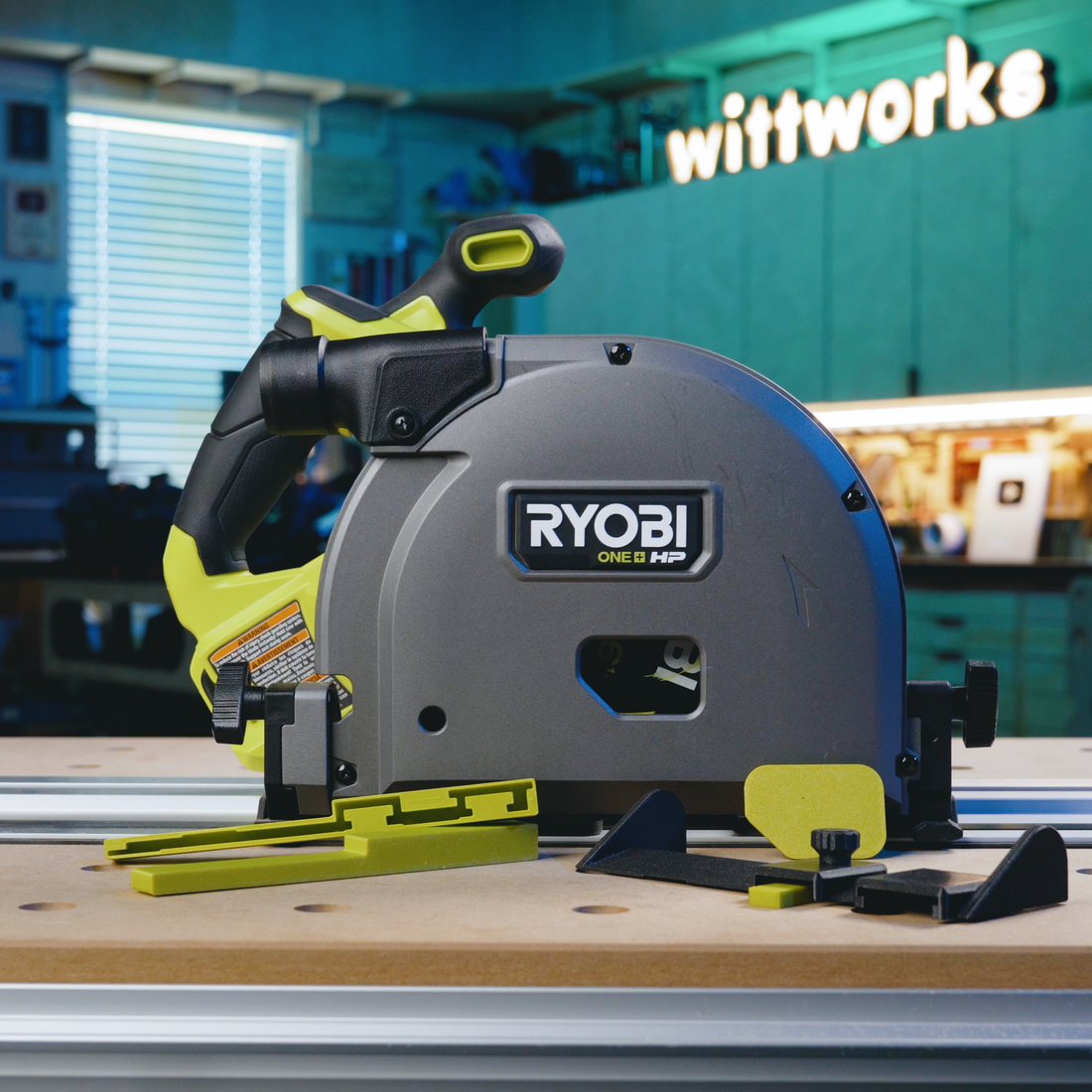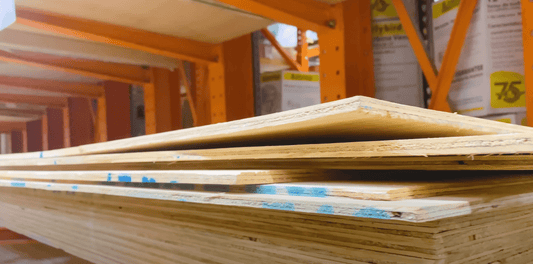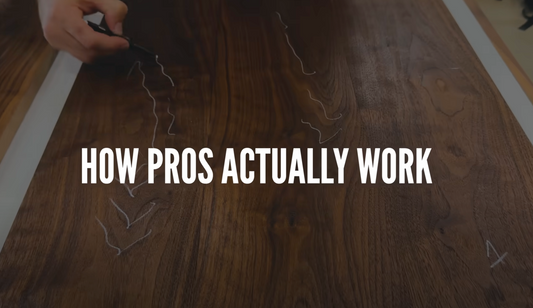
Track Saw Model: Ryobi
Share
Wittworks Track Saw Rating: 51 out of 100
Ryobi Track Saw Review: An Over-Priced Option for Budget DIYers
Track saws can be game changers in woodworking, especially when precision and clean cuts are crucial. But not all track saws are created equal. If you're eyeing the Ryobi track saw, here's a quick breakdown to help you decide if it's the right tool for you.
Fit & Finish: A Step Backwards
Score: 6/10
The Ryobi track saw feels cheaply made from the get-go. While it's functional, the plastic construction and overall build quality leave a lot to be desired. If you're used to more premium tools, the lightweight, flimsy feel might not inspire confidence.
Blade: Basic but Serviceable
Ease of Blade Change: 2/3
Changing blades isn’t a hassle, as the plunge depth can be easily locked into the right position for the blade change.
Stock Blade: 1/2
The stock blade is adequate, but don’t expect it to handle tough hardwoods with ease. You’ll likely want to purchase proper ripping and cross cutting blades to get the most of this saw.
Blade Size & Arbor: 6 ½” Blade, ⅝” Arbor
The Ryobi track saw doesn’t use the standard 165mm blade with a 20mm arbor (the hole size in the middle). Instead, it uses a typical 6.5” circular saw blade with a ⅝” arbor. These blades are less expensive compared to track saw blades and are readily available at home centers, which is why Ryobi did this.
Safety: Could Use Improvement
Riving Knife/Anti-Kickback: 2/5
The riving knife is poorly placed and interferes with the blade when plunging, which eliminates some of its helpfulness. Most other track saws plunge the riving knife separately to avoid this, something Ryobi should have thought of as well. You can still use the saw with the riving knife, but you need to fully plunge your saw on the track before entering your material.
Off-Cut Splinter Guard: 0/1
There’s no splinter guard to help clean up the outside edge of your cut.
Scoring Function: 1/1
The Ryobi has a scoring function that works as expected.
Depth Gauge: A Mixed Bag
Accuracy: 2/2
The depth gauge is accurate and gets the job done well.
Fine Tune Adjustment: 0/2
There’s no fine-tune adjustment to compensate for any variance in the depth guide scale.
User Experience: 2/3
It’s decent overall, but the quality of the depth stop makes it a finicky two-hand operation.
Dust Extraction: Not the Best
Hose Compatibility: 1/3
The hose doesn’t fit many common systems like Festool or CenTec, which limits your options for effective dust extraction out of the box, unless you have a Ryobi vacuum and hose, which it will fit. After 2 years of people asking, we finally designed a replacement port so users who have dust extraction hoses from CenTec, Rockler, and Festool and use it without a coupler.
Effectiveness: 2/3
The dust extraction is serviceable but could be better. You’ll likely see some dust buildup around your workspace.
Bevel Cutting: Room for Improvement
Readability/Detents: 3/4
Has a detent for 0 and 45, as well as the ability to reach -1 and 48 easily, but no 22.5. You would need to set that manually and test for accuracy.
Return to 90: 1/5
Returning to 90 degrees is a hassle, with some inaccuracy (up to 2 degrees off) meaning you’ll need to use a square to get a true 90 angle.
Anti-Tip: 1/2
The saw has an anti-tip feature, which is nice, but it’s not quite as sturdy as possible. If you’re not careful, when loosening the knob, the screw can come out and you could easily loose it and its washer.
Track Friction Adjustments: 1/3
Dialing in the track for smooth operation can be tricky, largely due to the poor build quality of the saw itself, not the track.
Motor: A Letdown for Heavy Duty Work
Variable Speed: 0/2
This saw has a single speed, which limits its versatility. If you plan to cut a wide range of materials, this could be a dealbreaker.
Sound & Feel: 2/5
It feels underpowered, and the sound reflects this — it’s not exactly a smooth, robust cutting experience. For simple plywood cuts, it’s fine. When cutting dense and thick hardwoods, you’ll notice the struggle.
2” Hard Maple Test: 2/5
The Ryobi struggles with hardwoods like oak and hard maple. If you plan to cut a lot of dense, tough materials, this isn’t the saw for you.
Track: The Best Part, Sadly
Build Quality: 5/5
The track itself is well-built, sturdy, and reliable. It’s clear that Ryobi is using high-quality materials for the track construction.
Design Profile: 1/4
Unfortunately, the design of the track is poorly executed. It’s not the standard guide rial profile that most track saws use, meaning most 3rd party accessories, including standard track saw clamps won’t fit.
Size Options: 2/3
The two 22 ½” tracks are decent enough, but if you plan to make long cuts regularly the 55” track will be a must. Ryobi does not make a 108” option like other brands do.
Rubber Splinter Guard Stickiness: 2/3
The splinter guard is okay but not as sticky or durable as higher-end models.
Anti-Slip Grips: 3/3
The grips are solid, ensuring the track stays in place during use.
Clamp Compatibility: 1/2
Clamp compatibility is limited. You will need to use the clamps Ryobi includes with the track saw, which are low quality and less than desirable.
3rd Party Accessory Compatibility: 0/4
The proprietary track design makes using third-party accessories such as popular guide rail squares and parallel guides impossible.
Warranty: Solid, But Not Outstanding
Score: 3/5
The 3-year warranty is a nice perk, but don’t expect much more than that. It’s standard for Ryobi, but some other brands offer better protection.
Price / Value: Questionable
Score: 5/10
At around $400, this track saw doesn’t offer the best value for the price. Given its performance and build quality, it should ideally be priced closer to $200. You’re paying for the versatile Ryobi battery platform, but there are better options at this price point.
Who is this Saw For?
The Ryobi track saw is a good option for home DIYers who are already invested in the Ryobi 18v battery platform. If you mainly work with plywood or softwood and are looking for something a little bit better than a circular saw, this tool could meet your needs. It’s also a good choice for those who don’t plan on using it for heavy-duty tasks or who plan on unlocking track saw efficiency with guide rail squares and parallel guides.
Who Should NOT Buy This Saw?
This saw is not ideal for professionals or anyone planning to cut a lot of hardwood or tackle precise, demanding cuts. If you’re a tools nob, you already know this isn't for you. The motor is underpowered, the stock blade doesn’t perform well with tough materials, and the track design limits your options for customization. If you’re after a tool that’ll last through years of heavy use, there are better options out there.
Final Thoughts:
The Ryobi track saw has its ups and downs. It’s not the most expensive saw and allows you to use the most popular battery platform in the world. It gets the job done for lighter DIY projects, but it’s not built for the long haul. If you need precision, power, or the ability to tackle tough materials, it might be worth looking at other models. For casual users sticking to softwood and plywood, it could be a decent tool to add to your collection. Just don’t expect it to outperform more premium competitors.




